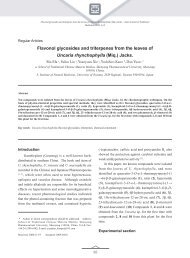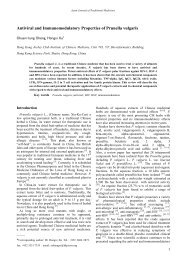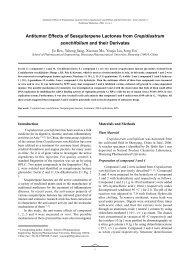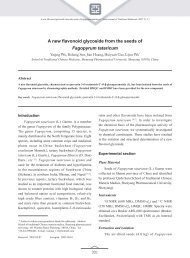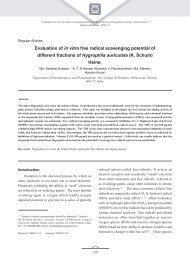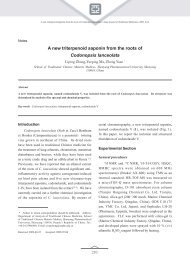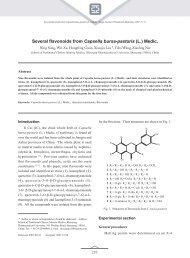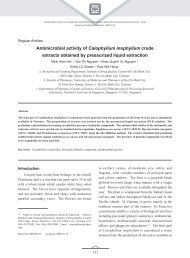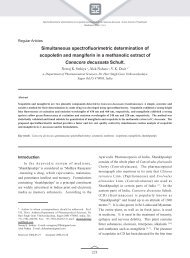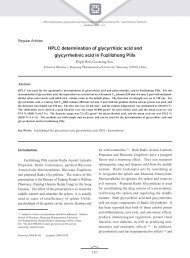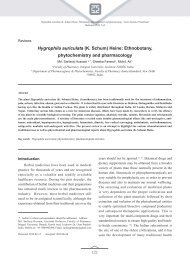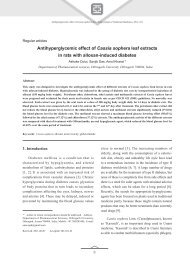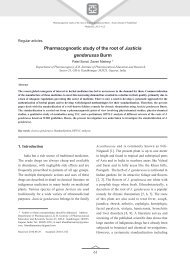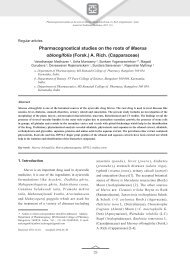Hepatoprotective and antioxidant activity of Zingiber chrysanthum ...
Hepatoprotective and antioxidant activity of Zingiber chrysanthum ...
Hepatoprotective and antioxidant activity of Zingiber chrysanthum ...
- No tags were found...
Create successful ePaper yourself
Turn your PDF publications into a flip-book with our unique Google optimized e-Paper software.
<strong>Hepatoprotective</strong> <strong>and</strong> <strong>antioxidant</strong> <strong>activity</strong> <strong>of</strong> <strong>Zingiber</strong> <strong>chrysanthum</strong> Rosec. rhizomes / Asian Journal<strong>of</strong> Traditional Medicines, 2011, 6 (6)as active principles in the essential oil <strong>of</strong> <strong>Zingiber</strong><strong>chrysanthum</strong> rhizome [8], there are very few scientificreports about its biological <strong>activity</strong>. In view <strong>of</strong> thesefacts, the present study was undertaken to evaluatethe hepatoprotective <strong>and</strong> <strong>antioxidant</strong> <strong>activity</strong> <strong>of</strong> theacetone <strong>and</strong> methanol extracts <strong>of</strong> the rhizome <strong>of</strong> thisplant.2. Materials <strong>and</strong> methods2.1. Collection <strong>of</strong> plant materialThe plant was collected locally from theTarai region <strong>of</strong> Uttarakh<strong>and</strong> <strong>and</strong> was identifiedtaxonomically from the Botanical Survey <strong>of</strong> India(BSI), Dehradun, Uttarakh<strong>and</strong>. The rhizomes wereseparated from the plants for the experiments carriedout in this study.2.2 Solvent extractionFor preparation <strong>of</strong> the acetone <strong>and</strong> methanolextracts <strong>of</strong> <strong>Zingiber</strong> <strong>chrysanthum</strong> (AEZC <strong>and</strong>MEZC) its rhizomes (500 gm) were shade dried<strong>and</strong> powdered. The powder was then subjected tocold extraction with 1000 ml acetone <strong>and</strong>1000 mlmethanol for 5 days. The dried acetone <strong>and</strong> methanolextracts were obtained by evaporation <strong>of</strong> the solventsusing a rotatory vacuum evaporator at 45 ºC±5 ºC<strong>and</strong> kept in a refrigerator until required for furtherinvestigation. The dried extracts were dissolved indistilled water before oral administration to differenttreatment groups.2.3. <strong>Hepatoprotective</strong> <strong>activity</strong>2.3.1. Experimental animalsFemale albino mice 2-2.5 months old weighingbetween 23-28 gm, were obtained from theExperimental Animal House, College <strong>of</strong> Veterinary<strong>and</strong> Animal Sciences, Pantnagar, Uttarakh<strong>and</strong>.The animals were maintained under st<strong>and</strong>ardmanagement condition <strong>and</strong> acclimatized for twoweeks before the start <strong>of</strong> the experiment. Feed <strong>and</strong>water were given ad libitum throughout the study.2.3.2. Experimental designTo evaluate the hepatoprotectivepotential <strong>of</strong>AEZC <strong>and</strong> MEZC in carbon trtrachloride (CCl 4 )-induced hepatic damage, fifty four mice werer<strong>and</strong>omly divided into nine equal groups viz. GroupI to IX. Group I served as a control. Group II to IXreceived a single dose <strong>of</strong> CC1 4 (3 ml/kg. b wt., i m)(99.8% MERCK Specialties Pvt. Ltd.) the on firstday. Group III served as a positive control <strong>and</strong> wasgiven a single daily oral dose <strong>of</strong> silymarin (3 mg/kgb. wt.) for seven days. Groups IV, V <strong>and</strong> VI were fedon a diet containing AEZC at 250 mg/kg, 500 mg/kg,<strong>and</strong> 750 mg/kg b. wt. <strong>and</strong> groups VII, VIII <strong>and</strong> IXwere fed MEZC at 250 mg/kg, 500 mg/kg <strong>and</strong> 750mg/kg b. wt., respectively, for seven days. The micein each group were sacrificed humanely after sevendays <strong>and</strong> blood was collected by cardiac puncture<strong>and</strong> transferred to sterilized non-heaparinizedsyringes to separate serum for biochemicalanalysis <strong>and</strong> liver was collected <strong>and</strong> preserved forhistopathological examinations. The serum wasstored at -10 ºC until biochemical analysis whichwas carried out within 24 hrs.2.4. Biochemical pr<strong>of</strong>ileBiochemical parameters including serumcholesterol, total protein, urea, triglyceride, albumin,glucose, bilirubin <strong>and</strong> serum AST, ALT <strong>and</strong> alkalinephosphatase [9-14] levels were determined usingdiagnostic kits (MERCK Specialties Pvt. Ltd, NewDelhi, India).2.5. Histopathological examinationThe sections <strong>of</strong> liver were processed forhistopathological examination involving tissuefixation <strong>and</strong> were then mounted using DPX formicroscopic examinations [15].243



